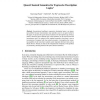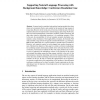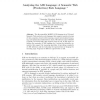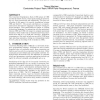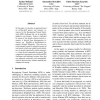DLOG
2009
14 years 4 days ago
2009
Abstract. Inconsistency handling in expressive description logics is an important problem because inconsistency may naturally occur in an open world. In this paper, we present the ...
WISE
2010
Springer
14 years 5 days ago
2010
Springer
Abstract. Regarding web searches, users have become used to keywordbased search interfaces due to their ease of use. However, this implies a semantic gap between the user's in...
SEMWEB
2010
Springer
14 years 6 days ago
2010
Springer
RDF(S) and OWL 2 currently support only static ontologies. In practice, however, the truth of statements often changes with time, and Semantic Web applications often need to repres...
SEMWEB
2010
Springer
14 years 6 days ago
2010
Springer
Systems based on statistical and machine learning methods have been shown to be extremely effective and scalable for the analysis of large amount of textual data. However, in the r...
SEMWEB
2010
Springer
14 years 6 days ago
2010
Springer
Abstract. The Rule Interchange Format Production Rule Dialect (RIFPRD) is a W3C Recommendation to define production rules for the Semantic Web, whose semantics is defined operation...
RR
2010
Springer
14 years 6 days ago
2010
Springer
The Accountability In RDF (AIR) language is an N3-based, Semantic Web production rule language that supports nested activation of rules, negation, closed world reasoning, scoped co...
PPDP
2010
Springer
14 years 7 days ago
2010
Springer
The Constraint Simplification Rules (CSR) subset of CHR and the flat subset of LCC, where agent nesting is restricted, are very close syntactically and semantically. The first con...
NAACL
2010
14 years 7 days ago
2010
In this paper, we describe an approach based on off-the-shelf parsers and semantic resources for the Recognizing Textual Entailment (RTE) challenge that can be generally applied t...
LPAR
2010
Springer
14 years 7 days ago
2010
Springer
Abstract. Recently, graded modalities have been added to the semantics of two of the logics most commonly used by the computer science community:
KR
2010
Springer
14 years 7 days ago
2010
Springer
Measuring the inconsistency degree of a knowledge base can help us to deal with inconsistencies. Several inconsistency measures have been given under different multi-valued semant...
